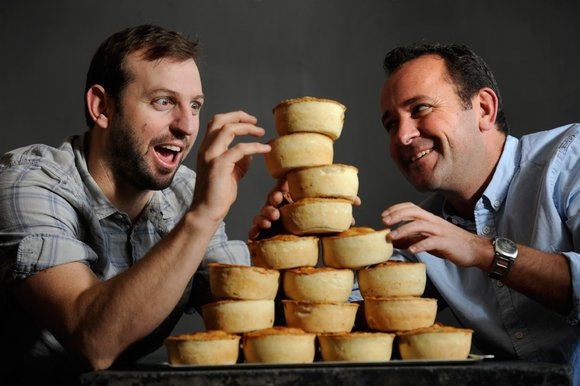A pie made with chicken, capers & corned beef or, if you dare, cured tongue.
This preparation with a surprising harmony is inspired by Fergus Henderson, who considers it restorative. It had better be: He requires you to brine a beef tongue for two weeks, soak it for a few hours and then simmer it for three more. Then, after all of the processing, you only use half of the thing. You need to boil, bone and butcher a whole chicken too, bind the meat with a capered white sauce and follow his rather elaborate instructions for puff pastry. A lot of labor, but this is not that, and the Editor’s decision to test a (relatively) streamlined version impaired the flavor of the pie not a bit. Go ahead and wrestle with the tongue if you like, but cured (corned or salt, all the same thing) works well as an alternative, and British suppliers like Marks & Spencer offer handy little 227 gram (about half a pound) cans of cured oxtail. You will need an eight inch pie plate or four appropriate ramekins. Enough for four hungry people.
 6 skinless chicken thighs
6 skinless chicken thighs- a carrot
- a leek
- a halved unpeeled onion
- 2 bay leaves
- some whole peppercorns
- about 1 teaspoon dried thyme
- 2 teaspoons Kitchen Bouquet (optional; see the Notes)
- Worcestershire
- about 1 pound cooked corned beef or cured tongue cut into ½ inch chunk
- generous Tablespoon unsalted butter
- 1-2 more onions, peeled and sliced into thin crescents
- 1 more Tablespoon unsalted butter
- 1 heaped Tablespoons flour (preferably Wondra)
- 2 cups milk
- some of the stock from cooking the chicken
- 2 Tablespoons small capers
- salt and pepper
- a sheet of frozen puff pastry, thawed
- a beaten egg
- Simmer the chicken with the carrot, leek, unpeeled onion, bay, peppercorns, thyme , Kitchen Bouquet and Worcestershire in enough water to cover until barely cooked, usually in about 30 minutes.
- Strain the stock and reduce it by half.
- Bone the chicken and cut it into sturdy chunks of 1 inch square or a little more.
Preheat the oven to 425°.
- Melt the first Tablespoon of butter over medium low heat and cook the onions with a little salt until limp but not colored.
- Toss together the beef or tongue, chicken and onions.
- To make the sauce, melt the second Tablespoon of butter over medium heat and quickly whisk the flour into the butter. As soon as the butter and flour marry (do not let the roux color), start dribbling the milk into the saucepan, whisking all the time, until the sauce becomes quite thick.
- Whisk at least a cup of the stock from simmering your chicken into the white sauce, and continue to simmer it until it reaches a the consistency of heavy cream.
- Stir the capers into the sauce.
- Meanwhile you have smeared the beef, chicken and onion mixture into either four ramekins or a pie platter; now slip the appropriate amount of sauce into each ramekin or stir all of it into the pie pan.
- Cover the filling(s) with the pastry, brush the the top(s) with the beaten egg and bake until the crust turns deep gold, usully in about 20 minutes for the little pies or 30-35 minutes for a big one.
Notes:
-The pie is better with the tongue because of what Henderson considers its “thoroughly giving” texture, but the marriage of chicken and corned beef, especially in the company of capers, represents an unexpected success.
-It is doubtful that Henderson would approve of storeboughts like Kitchen Bouquet or Worcestershire; they make no appearance in his recipes, most of which are rather austere of ingredient if not construction. Nonetheless they add depth and zip respectively to most stocks, pie fillings or stews.
-Henderson is a recipe writer of the Elizabeth David School, someone who eschews not just precise quantities but also detailed instruction. He favors a hybrid style both flash and languid. We therefore should poach a “happy chicken” with unspecified amounts of leek, onion, garlic and peppercorns before cutting it into “pie-sized chunks.” From Beyond Nose to Tail, A Kind of British Cooking: Part II (London 2007) 56, written with Justin Piers Gallatly, who helped with pastry and pudding recipes.
-He likes silly names and aphorisms. “Orbs of Joy’ are braised whole red onions and there is “Unctuous potential: Trotter Gear is your gastronomic friend.” It also is, for the uninitiated, simply pork jelly. All this is either amusing or irritating in much the way that attitude determines whether some things are either adventures or ordeals.
-Sometimes Henderson’s format is very nearly perverse. Readers are told to bake things in a ‘slow,’ ‘moderate’ or ‘hot’ oven in the text; an appendix of “Conversion Tables” provides the temperatures that you should not need to leave the recipes to find.
-To prepare Orbs of joy, which would be good with any simply roasted bird, follow Henderson’s characteristically imprecise and not quite grammatical instructions:
“Peel some red onions but keep them whole. Put in an oven dish and add chicken stock until they are almost covered. Braise them in a medium [350°] oven. As they cook, the stock around them will reduce slightly, giving your onions a slightly singed and caramelized exterior and a pale pink and totally giving [Henderson likes ‘giving’] interior. Truly an orb of joy!” (Henderson 74)

